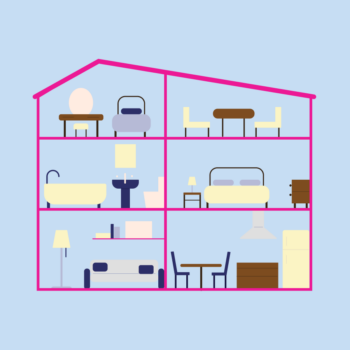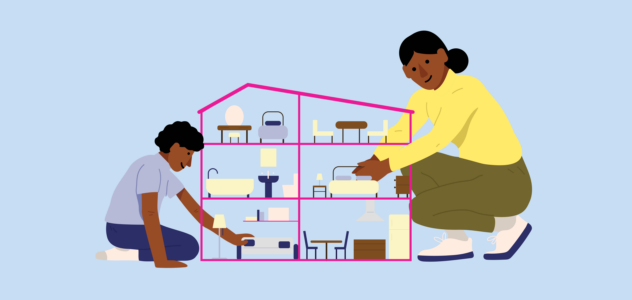Whether it’s a full overhaul or a minor spruce up, there’s no avoiding the fact that renovations cost money.
And unfortunately, many homeowners use up most of their savings to buy a house and chip away at their mortgage. So how on earth do you fund a renovation?
Well, a renovation home loan is exactly what it sounds like – it’s using (or adding) to your home loan to fund a renovation.
And it can be a (rather handy) way to fund a renovation, especially if you don’t have the money available upfront.
So, how do you borrow extra on your mortgage for renovations? What are the pros and cons? And are there any other options to fund renovations?
Using equity for renovation home loans
You’ve no doubt heard of the term equity – it’s the difference between the value of your property and the amount you still owe.
So as you pay off more of your home loan, the more equity you have. Similarly, the more your property value increases, the more equity you will have.
The exciting part? You can use this equity to borrow more money to fund a fancy renovation (also referred to as a “cash-out” refinance or a “top up” home loan). At the end of the day, this will increase your home loan and how much you owe – but it can help you pay for a renovation when you don’t have the money upfront.
But using equity for a home loan doesn’t always look the same. You can also use an offset account or redraw facility – which are also technically forms of equity.
Using offset accounts and redraw facilities to fund a renovation
An offset account functions like an everyday bank account where you can easily withdraw and deposit money (only it’s attached to your home loan). The good thing about an offset account is it’s often incredibly easy to access the money. On the flip side, it may mean it takes longer to pay down your loan (you’re withdrawing money that ‘offsets’ your mortgage), and it will mean you’re paying more interest each month.
A redraw facility is an extra feature on your home loan that allows you access to extra repayments you’ve made. Just like an offset account, it’s relatively easy to access the money. But the same scenario here, it may mean it takes longer to pay down your loan (you’re using repayments that you already added to your mortgage).
Pros and cons of using equity for a renovation home loan
As with most things in the property buying world – there are pros and cons to using equity to fund a renovation.
Pros
- You can start your renovations, sooner
- You can avoid paying money up front (especially if you don’t have the money to fund it straight up)
- You can add value to your home, sooner, by giving it an overhaul
- The value you add to your home may be more than the money you spend on the renovation – hello, even more ‘equity’
- When you’re in the process reviewing your home loan to fund a renovation, you might also be able to refinance to a better rate while you’re at it (this can ultimately help you save $$$)
- It’s a chance to fix any pressing issues or structural damage (which could cause issues down the track and become more costly)
- Avoids taking out a personal loan which can come with a nasty interest rate.
Cons
- You’re adding to your home loan again (but you could also think of it as a step back to take steps forward)
- Your monthly repayments may increase
- Even if you have equity, you may not be able to service (AKA ‘afford’ in the eyes of the lender) the new loan amount so a bank may not approve you
- It could lengthen the time it takes to pay off your home loan
- You need to have equity in your home in the first place (it might take a few years to build this up, so you might not be able to renovate straight away)
What do you need to do to access equity for a renovation?
Typically, the lender will need to understand how much equity you have to access, plus your ability to afford the total lending amount (after you get the new loan).
To understand your equity, they will run a simple online valuation of your property, or in some cases, a full valuation.
Once they know the current value of your property, they’ll want to ensure you can afford the loan. This involves understanding your financial position (like employment, liabilities, and money coming in and out) and running a credit check so they are satisfied you will be able to repay the loan. Then, it’s a matter of refinancing.
Meet Tash, she decided to use equity to renovate
Tash’s house is valued at $800,000 and she has $350,000 outstanding on her loan. That means she has $450,000 in equity in her property. She decides to use some of this equity to take out a renovation home loan.
She works out the renovations will cost a total of $50,000, so she loans this amount from her lender.
That means she now has $400,000 outstanding on her loan (and $400,000 left in equity in her property).
This will mean her monthly repayments will increase (she now owes more on her loan). But she decides it’s worth it, because renovating her property will add significant value to her home – plus, she gets to enjoy a new interior that’s exactly to her style.
How can I fund my renovation? Are there other options?
Tapping into your equity isn’t your only option to fund a renovation.
Use your savings
If you’ve got enough savings built up, you might want to use those to fund your renovation rather than adding to your home loan.
- The pros – you won’t be lengthening your home loan (by paying upfront, you could pay less over the life of your loan)
- The cons – you’ll really feel a dent in your savings (and potentially have to forgo that big European holiday next year!)
Take out a personal loan
Last but not least, you can take out another loan to pay for your renovation, in the form of a personal loan. This could be an option if you haven’t built up enough equity in your home.
- The pros – they can be a solid option if you don’t have enough equity or need to fund a smaller loan – it doesn’t add to your home loan.
- The cons – they often come with higher interest rates and shorter loan terms (you could be making higher repayments in the short term).
Note: it’s a good idea to chat with a mortgage broker about your home loan options *before* you take out a personal loan (it often makes sense to start with your lowest interest option, usually your home loan). Once you’ve crunched the numbers, you may actually decide to press pause and revisit your renovation plans in a year or so, depending on what your options are.
So, should you borrow extra on your mortgage for home renovations?
If you’ve built up enough equity and you’re keen to renovate ASAP, it could be a good option to borrow extra on your mortgage to fund a renovation.
In saying that, every situation is unique, so we can’t give you a definitive yes or no without getting to know YOU first. For example, you might find that using your savings, offset account or redraw facility works better for you – or you might choose to refinance or take out another loan.
Whatever you’re thinking, a Finspo home loan expert (AKA mortgage broker) can clear things up and point you in the right direction, all so you can enjoy your fancy renovation, sooner.
Meeting with a Finspo home loan expert is easy, free and totally non-intimidating.










































































































